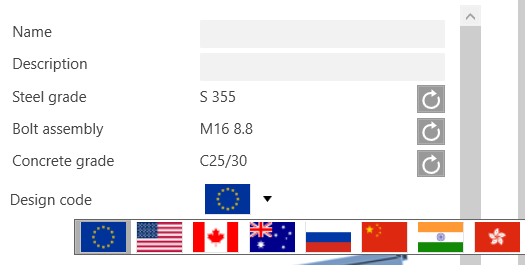Codes and standards supported in IDEA StatiCa Steel
For now, IDEA StatiCa Steel users can choose from 8 international or national codes and standards. Some of them are used almost worldwide, some are really localized.
- AISC - American Code of Standard Practice for Steel Buildings and Bridges
- EN - Eurocode - used in the majority of European countries (without national annexes)
- CISC - Canadian Code of Standard Practice for Structural Steel
- AS - Australian Standards and Codes of Practice
- SP - Russian National Standards
- GB - Chinese National Standards
- HKG - Hong Kong Code of Practice for the Structural Use of Steel
- IS - Indian Standards (added in May 2020)
We at IDEA StatiCa are fully aware of the fact, this range of codes does not cover all the needs of structural engineers worldwide. But still, we add at least 1 or 2 national codes to every single product release which are coming regularly twice per year. Obviously the complexity of the software maintenance grows with every single newly added code.
Regional/code-based localization
To support any of these above-mentioned codes does not mean only we add code-check comparisons and "traffic lights" for the specific standard. Our intention is to keep the user's experience straightforward and efficient to speed up his/her design and code-checking process.
Some of these localizations aren't visible at first glance. But once you switch your code settings, e.g. because your next projects will be designed according to Euroced instead of AISC, you will notice that change in the application, for sure.
Your cross-section library will re-shuffle so the most common cross-sections for the selected code/region are listed on top. The same happens to your connection wizard, where the typical topologies for the chosen code will list up first. There are some typical steel grades, bolt grades, and cross-sections used in every region covered by one of the codes. These will be set as preferred in the application when choosing the related code.
If you are curious about how to reset the code, you can follow the default settings reset described in this post.
Trust, but verify
This sentence became known thanks to Ronald Regan who used it quite often during the discussions with the Soviet Union about denuclearization (well, in fact, it is a Russian proverb originally :-)). But it feels like it is valid for every single structural engineer in the world as well.
That's why all the supported codes are fully covered also from the theoretical point of view. Our team worked hard to prepare a detailed Theoretical background for every single supported code or standard.
Except for the theoretical background for a specific code, you can go through a detailed General theoretical background valid worldwide. It is describing the basic principles of the Component-based Finite Element Method, which powers the Steel application.
Besides the theoretical background, you can find in the Support Center many Verification examples based on various codes. Most of them on AISC and Eurocode, but there are some for CISC and AS standards as well.
Conclusion
To have its results aligned with as many regional codes as possible is the target of every structural design software. We at IDEA StatiCa are following our step-by-step strategy of expanding to new regions/codes. We are listening carefully to our customers and meanwhile assess the pros and cons of each potential standard to be added to our growing list. So, don't be afraid to tell us which code you would like to have implemented in IDEA StatiCa next time.




